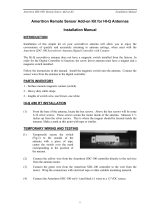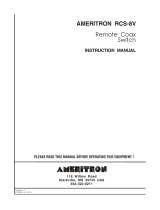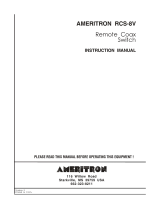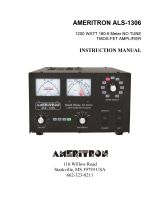Page is loading ...

ATR-20 Instruction Manual Ameritron Antenna Tuner
1
1.0 INTRODUCTION
The ATR-20 is a high power antenna tuner. The ATR-20’s roller inductor "T" matching network
continuously tunes all frequencies from 1.8 through 30 MHz. It also features a built-in 3 kilowatt peak or
average detecting directional power meter. The ATR-20 has rear panel connectors for coaxial and wire
feedlines. A heavy duty, high voltage insulated, current-type balun allows use with balanced feedlines.
Properly tuned, the ATR-20 safely operates on all bands with RF power levels of 1.2 kilowatts SSB and
600 watts CW with load impedances from 25-800 ohms. Matching range also extends from one ohm to
2500 ohms (5 ohms to 500 ohms on 160 meters) at slightly reduced power ratings. Peak and average
forward power, reflected power, and SWR are displayed on an illuminated cross-needle meter.
An internal six position antenna-selector switch selects three coaxial line outputs, or a single wire line-
balanced line output. Two coaxial line outputs, ANTENNA 1 and 2, are available in either “tuned”
(with tuner's matching network in line) or “direct” (no matching circuit) configurations.
Coaxial output port ANTENNA 3 is available only as a direct (no matching system) configuration.
WIRE / BALANCED LINE positions are available only as “tuned” configurations.
1.1 Understanding Power Ratings
Unlike amateur radio service amplifiers (commonly rated in RF power output delivered to 50 ohm
resistive loads), tuners have no standard power rating method. Power level descriptions (i.e. “3 kW
Tuner”) used for tuners often carry over from the time when amplifiers were rated by peak power input.
For example, the Kilowatt Johnson Matchbox was designed to handle a typical 1000 watt dc input plate
modulated AM transmitter. Such transmitters developed 3000 watts PEP RF output on AM. Matching
tuners were called one kilowatt tuners.
Years later SSB became popular. The Heathkit SB-220 was called a two kilowatt amplifier, even though
rated CW output was approximately 600 watts. Tuners from the same era were called 2 kilowatt tuners,
because they safely handled the 2 kilowatt PEP input SB-220. The 2 kW tuner only had to handle 600
watts of CW and 1200 watts PEP SSB to be compatible with a 2 kW amplifier of the same era.
Around 1980, the FCC changed the amateur radio power rating system from dc power amplifier input
power to RF envelope (output) power. Most tuners stayed with the old system, and no longer follow
amplifier power ratings. Typical “1500 watt tuners” safely handle only 400-600 watts CW, and 600-900
watts PEP SSB.
Note: This tuner is rated by true RF output power, not by the old method of using amplifier peak input
power.
Load conditions and control settings greatly affect tuner power ratings. T-networks typically handle
more power on higher frequency bands into higher load impedances. The worst operating condition (for
T network tuners) is a low-impedance capacitive-reactance load. T-network tuners handle the least
power on 160 meters with low-impedance capacitive-reactive loads.
Follow the guidelines in this manual to avoid exceeding the ratings of this tuner!

ATR-20 Instruction Manual Ameritron Antenna Tuner
2
1.2 Peak Reading SWR/Wattmeter
The ATR-20’s cross-needle meter displays peak or average FORWARD power, peak or average
REFLECTED power, and SWR.
The wattmeter can be used without the tuning network by setting the ANTENNA SELECTOR to any of
three COAX DIRECT positions of the antenna selector. The wattmeter is active in all six positions of
the ANTENNA SELECTOR switch.
The ATR-20 must have a power source, or the meter won’t function. Power can be provided by an
external 12 Vdc supply (negative ground only) or an internal 9 Volt “transistor radio” battery. The meter
lamp will not illuminate unless an external supply is used.
Battery life is greatly increased through use of an RF controlled solid state battery switch. After a short
period of inactivity, the battery is electronically disconnected.
Full scale forward and reflected power range is controlled by the left METER switch, selecting 3000
watt (HI) or 300 watt (LO). If your transmitter runs more than 300 watts of peak output power, set this
switch to the 3000 watt HI (in) position. If your transmitter has less than 300 watts of peak output, set
this switch to the 300 watt LO switch position (out). Peak envelope power (PEP) is measured by placing
the PEAK or AVG push button (middle METER button) in the PEAK (in) position.
Peak and average power values are equal with steady unmodulated carriers such as closed-key CW,
RTTY, FSK, or FM. The meter reading on these modes will be the same in either peak or average
modes. On SSB, the ratio of PEP to average power varies with different voice and modulation
characteristics. With most voices, the PEP reading is three to five times higher than the average voice
power reading.
Forward power is displayed on the left-hand FORWARD meter scale. This scale is calibrated from 0 to
300 watts and is read directly in the 300 watt LO METER position. Each picket (scale mark) represents
5 watts below 10 watts, 10 watts between 10 and 100 watts, and 25 watts between 100 and 300 watts. In
the 3000 watt (HI) position, multiply the forward power scale 10 times (EXAMPLE: 50 = 500 and 150
=1500 watts).
Reflected power is read on the right-hand REFLECTED meter scale. Full scale reflected power is 60
watts when the meter switch is in the LO position , and 600 watts in the HI position. This scale is
marked with a picket every one watt below 10 watts and every 5 watts above 10 watts. This scale is also
multiplied by 10 when using the HI meter power position.
Power readings are most accurate over the upper half of the meter scales. When measuring power with a
less than perfect match, subtract reflected power from forward power. The result will be the true power.
SWR is read directly from eleven red SWR curves that range from 1:1 to infinity. SWR is measured by
observing the point where forward and reflected meter pointers cross. The SWR is indicated by the red
curve closest to the pointer crossing point. No cumbersome or time consuming SWR sensitivity
adjustments are required with this method.
The power meter and turns counter are backlit with internal lamps. The meter and counter lamps require
power from an external 12 Vdc source. A rear panel jack accepts a 2.1 mm coaxial plug with the center
conductor positive (+) and the outer sleeve negative (-) for powering lamps and metering circuitry. The
negative lead (outer sleeve) is grounded inside the tuner. A meter ON / OFF switch turns the meter and
turns counter lamps off and on, and also turns the meter circuitry off when using battery power.
1.3 Antenna Selector

ATR-20 Instruction Manual Ameritron Antenna Tuner
3
The ANTENNA SELECTOR selects one of 3 rear panel SO-239 coaxial connectors or the wire-type
wing-nut connections. Of the three rear panel coaxial connectors, only COAX 1 and COAX 2
connectors are available using the matching network in the tuner. COAX 3 is bypass only, with no
tuning functions available. Single wire or balanced wire outputs are available only as tuned antennas.
2.0 INSTALLATION
CAUTION: To prevent RF burns from high voltages when using open wire
or single wire feeds, locate the tuner to prevent rear panel
connections from being accessible during operation. Be sure
the tuner is properly grounded.
1. A power source must be connected for the power meter to operate. There are two choices:
a. Connect a 12 Vdc power source to the back of the tuner marked 12 VDC. This method will also
supply power to the meter and turns-counter lamps.
b. Remove the small bottom cover from the tuner and connect a standard 9 volt battery to the battery
clip. Snap the battery into the metal holder, and replace the battery cover. When a 9 volt battery is
used as the only power source, meter and turns-counter lamps will not function.
2. Locate the tuner in a convenient location at the operating position. If random wire or balanced lines
are used, the rear panel ceramic feed-throughs may operate with high RF voltages. These voltages can
cause serious RF burns if contact is made with ceramic standoff terminals while transmitting. Locate
the tuner where the wire feedline terminals can not be contacted during operation.
3. Install the tuner between the transmitter and the desired antennas. Use good quality coaxial cable
(such as RG-8/U) to connect the transmitter (or amplifier) to the rear panel connector marked
“TRANSMITTER”.
4. Connect the antenna(s) to the tuner as follows:
a. Coaxial feedlines that might require use of the tuner connect to coax connectors 1 and 2. Coaxial
cables not requiring a tuner connect to coax connector 3.
b. Single wire feedline antennas should be connected to the WIRE connector on the back of the
unit.
c. Balanced feedlines (open wire, twinlead, or twin-axial lines) are connected to the BAL. LINE
terminals and a short jumper is installed between the WIRE post and the unmarked post below it.
WARNING High RF Voltages! Route all single and open wire feedlines
to prevent RF burn and arcing hazards.
5. A ground post is provided for an RF ground connection. This tuner must always be connected to the
station ground buss.
3.0 OPERATION

ATR-20 Instruction Manual Ameritron Antenna Tuner
4
The roller inductor has
maximum inductance
when fully counter-clockwise (turns counter 000) and
minimum inductance
when fully clockwise (turns counter approximately 124) on the reference counter.
The capacitors have
maximum capacitance
at 0 and
minimum capacitance
at 10. In simple language, as
frequency is increased normal control operating positions rotate clockwise.
Note
: Always use the most capacitance (capacitor settings closest to 0) allowing a “match”. This
insures the tuner is being operated with the highest power handling capacity and least loss
possible. Use the lowest possible inductance (the highest number possible) on the turns counter.
Increasing the capacitor setting numbers and decreasing the INDUCTANCE number (on a given
frequency) INCREASES matching range. This also REDUCES efficiency and power handling
capability of the tuner!
3.1 Initial Antenna Tuning
1. Tune the exciter into a dummy load (most solid state transmitters are "pre-tuned" to 50 ohms and do
not require adjusting with the dummy load).
2. Select the desired antenna with the ANTENNA SELECTOR.
3. Position the ANTENNA, TRANSMITTER, and INDUCTANCE controls at the following
settings:
Band ANT/TRANS IND Band ANT/TRANS IND
160 M: 1 45 20 M: 3 118
80 M: 1 93 17 M: 3.5 119
75 M: 1.5 98 15 M: 4.5 120
40 M: 2 111 12 M: 5 121
30 M: 2.5 116 10 M: 6 121
4. Place the POWER switch in the LO and AVG meter positions, apply a slight amount of power (25
to 50 watts).
5. Starting from the recommended INDUCTANCE position for the band used, turn the
INDUCTANCE control counter-clockwise (adding more inductance). Tune for lowest reflected
power and maximum forward power (best SWR).
6. In order, adjust the ANTENNA and TRANSMITTER controls for lowest reflected power (best
SWR). Repeat this step a few times until the reflected power is zero or as close to zero as possible.
7. If SWR did not reach 1:1 in step 5, turn the INDUCTOR control counter counter-clockwise (to a
lower number) and repeat Step 5. For maximum power handling and efficiency, always adjust the
capacitors to the lowest front panel number (highest capacitance) that allows proper antenna
matching. This insures maximum power handling and lowest power loss in the tuner.
8. Fully advance the power and, if necessary, touch up the ANTENNA and TRANSMITTER controls
for minimum reflected power and maximum forward power (lowest SWR). Remove the power.

ATR-20 Instruction Manual Ameritron Antenna Tuner
5
9. After adjusting the tuner for minimum SWR, the amplifier may be turned on. The METER switch
should be placed in the HI position, and the amplifier tuned according to the manufacturer's
instructions.
10. For quick retuning of the tuner, record the control settings for each band and use them as starting
points.
Note: Maximum power handling occurs when both the TRANSMITTER and ANTENNA
capacitors are set at the lowest front panel numbers that permit matching the antenna.
Following this guideline will insure maximum power handling capability and efficiency, and
the least critical tuning adjustments.
4.0 OPERATING HINTS
1. While this tuner is designed to have the largest tuning range possible, there are limits to the range of
individual components. Some antennas may require either more or less capacitance, or more or less
inductance than practical components provide. In these special cases, SWR may not reduce to 1:1. If
the SWR is higher than acceptable, changing antenna or feedline length will probably bring the
antenna impedance within the useful tuning range.
2. When adjusting the tuner, use the lowest number on the TRANSMITTER and ANTENNA, and the
highest INDUCTOR number, that produces a good SWR. This reduces tuner losses and increases
tuner power rating.
WARNING:
1. Never operate the tuner with the top removed. Voltages inside the tuner can cause painful RF burns.
2. Never rotate the ANTENNA SELECTOR switch while transmitting. Doing so may permanently
damage the switch.
3. If you use balanced or single wire feedlines, locate the tuner where the rear terminals can
NOT
be
contacted by people, wiring, or metallic objects. The single wire and balanced line connections will
generally have high voltages when used. Be sure the tuner case is properly grounded.
4. Disconnect all antennas from the tuner during lightning storms. Do not depend on lightning
“protectors”.
5. Tune with low power (i.e. less than 100 watts). Apply high power only after tuning up.
4.1 In Case Of Difficulty
If the tuner fails to tune, double check all connections and follow the tuning procedures again. Be sure
to use
enough inductance
(lower number) and have the
capacitors open far enough
(higher front panel
numbers).
If the tuner arcs at the rated power levels, double check all connections and follow the tuning
procedures again. The typical RF power rating of this tuner is 1200 watts PEP into load impedances
between 25 and 800 ohms, and less into higher or lower impedance loads. Always use the
least amount
of inductance
(highest number) and the
greatest capacitance
(lowest number) possible that still allows
matching the load on the operating frequency.
Note: If internal arcing occurs it may be necessary to reduce transmitter output power or modify
antenna or feedline length.

ATR-20 Instruction Manual Ameritron Antenna Tuner
6
If unsuccessful, but the tuner does adjust and operate when switched to a dummy load or a different
antenna, read the
Antenna System Hints
section.
5.0 GROUNDING
To minimize RFI, single wire feedlines (such as used with Windom or longwire antennas) should be
kept away from other wiring. Radiation will be minimized if the single wire feeder runs parallel and
reasonably close to the wire that connects the tuner to the outdoor ground. The antenna feed wire should
be adequately insulated to prevent arcing or accidental contact.
Safety requires good dc and RF tuner grounding. It is particularly important to have a good RF ground
while using a single wire feeder. When using a single wire feeder, the tuner needs something to "push"
against in order to force current into single wire feedlines. If a good RF ground is not available, RF will
usually find it's way back into the power line (RFI), transmitter audio circuits (RF feedback), or the
operator (RF burns).
Water pipes and ground rods provide good dc and ac safety grounds, but they are often inadequate for
RF grounding because they are single conductors. Ground rods by themselves are almost useless for
dependable RF grounding.
RF grounds perform better when "spread out" over a large area, especially when they employ multiple
connections directly to the equipment ground point. Water pipes, heating ducts, and fences may work
well enough in many cases (especially if they are connected together with multiple wires), but the best
RF grounds are radial systems or multi-wire counterpoises. Radials and counterpoises provide large, low
resistance surfaces for RF energy.
RF and lightning travels on the surface of conductors. Braided or woven conductors have high surface
resistance for lightning and RF currents. Ground leads for RF and lightning should have wide smooth
surfaces. Avoid the use of woven or braided conductors in RF and lightning grounds unless the lead
needs to be flexible.
CAUTION: For operator safety, a good outside earth ground or water
pipe ground should always be installed and connected to the
case of the ATR-20. Make certain the safety ground also
connects to the transmitter and other station accessories.
A wing nut post marked GROUND is provided for ground
connection(s).
6.0 ANTENNA SYSTEM HINTS
1. Many people believe a ladder line fed antenna requires a 4:1 balun. The input impedance of a ladder
line feedline can actually range from a few ohms to many thousands of ohms, depending on feedline
and antenna length. The best balun for such systems is always a 1:1 current type balun. A current or
choke-type balun guarantees minimum feedline radiation and maximum balun efficiency and power
handling.
2. As a general rule, all balanced antennas should employ a choke-type balun at the feedpoint when fed
with unbalanced (coaxial) feedlines. It is often a good idea to use a choke balun near any coax fed
antenna regardless of antenna type. Considerable common mode currents can flow on the outside of

ATR-20 Instruction Manual Ameritron Antenna Tuner
7
coaxial cables, even when feeding groundplane or gamma matched antennas, since systems are
seldom perfectly designed or constructed.
3. Avoid feeding unbalanced antennas (like verticals) with balanced feedlines. Even if a good balun is
used at the tuner, the line will still radiate.
4. Good antenna and feedline balance will often reduce RFI to your neighbors, as well as reduce noise
coupled into your receiver from the feedline.
6.1 Location
For the best performance, an end-fed longwire wire antenna should be at least one quarter-wavelength
long at the operating frequency. Horizontal dipole antennas should be at least a half-wavelength long
and located as high and clear as possible. While good RF grounds help the signal in almost any
transmitting installation, it is extremely important to have good RF grounds with long wire or other
Marconi style antennas.
6.2 Matching Problems
Most matching problems occur when the antenna system presents an extremely high impedance to the
tuner. When the antenna impedance is much lower than the feedline impedance, an
odd quarter-
wavelength
feedline converts the low antenna impedance to a very high impedance at the tuner. A
similar problem occurs if the antenna has an extremely high impedance and the transmission line is a
multiple of a half-wavelength. The half-wavelength line
repeats
the very high antenna impedance at the
tuner. Incorrect feedline and antenna lengths can make an otherwise perfect antenna system very
difficult or impossible to tune.
One example where this problem occurs is on 80 meters when an odd quarter-wave (60 to 70 foot) open
wire line is used to feed a half-wave (100 to 140 foot) dipole. The odd quarter-wave line transforms the
dipole's low impedance to over three thousand ohms at the tuner. This is because the mismatched
feedline is an
odd multiple
of 1/4 wavelength long. The line
inverts
(or teeter-totters) the antenna
impedance.
A problem also occurs on 40 meters with this same antenna example. The feedline is now a multiple of
a half-wave (60 to 70 foot) and connects to a full-wave high impedance antenna (100 to 140 foot). The
half-wave line repeats the high antenna impedance at the tuner. The antenna system looks like several
thousand ohms at the tuner on 40 meters.
This places enormous strain on the balun and the insulation in the tuner, since voltages can reach several
thousand volts. This can cause component arcing, heating, and failure.
The following suggestions will reduce the difficulty in matching an antenna with a tuner:
1. Never center feed a half-wave multi-band antenna with a high impedance feedline that is close to an
odd multiple of a quarter-wave long.
2. Never center feed a full-wave antenna with any feedline close to a multiple of a half-wave long.
3. If this tuner will not "tune" a multi-band antenna, add or subtract 1/8 wave of feedline (for the band
that won't tune) and try again.
4. Never try to load a G5RV or center fed dipole on bands far below the half-wave design frequency. If
you want to operate an 80 meter antenna on 160 meters, feed either or both conductors as a longwire
against the station ground.

ATR-20 Instruction Manual Ameritron Antenna Tuner
8
To avoid problems matching or feeding any dipole antenna with high impedance open wire lines, keep
the lines around the length below. The worst possible line lengths are shown in brackets:
160 meter dipole 40-70 or 150- 190 feet suggested [Avoid lines around 120 or 240 ft]
80 meter dipole 25-40, 80-100 or 140-160 feet [Avoid lines around 60, 120, or 180 ft]
40 meter dipole 40-50, 70-80, 100-110 or 130-140 feet [Avoid 30, 60, 90, 120 ft]
Some slight trimming or additional feedline may be necessary to accommodate the higher bands.
WARNING: To avoid problems, a dipole antenna should be a full half-
wave on the lowest band. On 160 meters, an 80 or 40 meter
dipole antenna fed like a normal dipole will be extremely
reactive with only a few ohms of feedpoint resistance.
Trying to load an 80 meter half-wave (or shorter) dipole
antenna on 160 meters can be a disaster for both your signal
and the tuner. The best way to operate 160 meters with an 80
or 40 meter dipole antenna is to load either or both (in
parallel) feedline wires as a longwire or ‘‘T’’ antenna. An
antenna connected like this and worked against a very good
RF ground will produce a very good 160 meter signal.
7.0 TECHNICAL ASSISTANCE
If you have any problem with this unit first check the appropriate section of this manual. If the manual
does not reference your problem or your problem is not solved by reading the manual, you may call
Ameritron
at 662-323-8211. You will be best helped if you have your unit, manual and all information
on your station handy so you can answer any questions the technicians may ask.
You can also send questions by mail to Ameritron, 116 Willow Road, Starkville, MS 39759; by
Facsimile (FAX) to 662-323-6551. Send a complete description of your problem, an explanation of
exactly how you are using your unit, and a complete description of your station.


ATR-20 Instruction Manual Ameritron Antenna Tuner
10
Tuning Log
Use the log below to record settings for your antennas. You may want to copy this chart and post it by
your tuner.
Antenna
type
Frequency
(MHz)
Transmitter Antenna Inductor
1.8
1.8
2.0
2.0
3.5
3.5
3.5
3.75
3.75
3.75
4.0
4.0
4.0
7.15
7.15
10.1
10.1
14.2
18.1
18.1
21.2
21.2
24.9
28.5
/
















